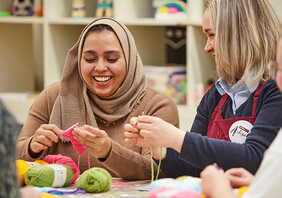How to Use a Knitting Machine
The instruction manual for the Silverreed LK150, is so clear and a real beginners guide explaining everything from start to finish, it explains what it is, what it does, how it works, techniques and making garments. I have below created a little how to guide with some pictures so show you how I went about using the machine.
You will need
How to make
The yarn is always placed at the back at the machine, the only time it will ever be at the front is if you are working intarsia, weaving or decorative e wrapping. The yarn as mentioned previously would have been wound already or placed in a yarn bowl.

Depending on the yarn that you use will depend upon the tension you will choose on the dial. I am using Women's Institute Premium Acrylic DK yarn and I have found the best tension to work in for this is 4.
Bring the yarn from underneath your carriage and work with the first needle on your left. Taking the yarn in between the last 2 needles and then wrap over the left needle, rep this step – yarn between the next 2 needles, take the yarn over the left and continue until the last st.
Note: Make sure that you have casted on these stitches loosely as it will be difficult for your first row of knitting.










Using the needle selection tool and using 0 as the centre point bring out your needles to work with into 'D' position.


Thread the left hand side of the tension mast and have 2 yarns in action (to work at a similar tension it is best to work with the same weight yarn).

With using the transfer tools you simple transfer stitches from one needle to another. (images below)






Tucking creates a little volume in your work and also works great with 2 colours. To start, with the carriage on your right bring the needles you wish to tuck (hold the yarn) into 'D' position and change the levers from II to I (holding) on both sides.
Take your carriage across and what you will notice is that your 2nd colour has knitted the needles in ‘B’ position and laid over the needles on I, knit for a further 3 rows and return your main colour into the feeder and rest 2nd colour at the back, move the levers back to II on both sides and knit 2 rows.
Note: you must remember where you had your needles out into tuck position if you want to repeat the pattern so have a pen and paper ready.



Once you have finished your knitting you are ready to cast off. Make sure the carriage is on the right hand side and that you have the single transfer tool in hand.









Repeating from * to* until the last stitch where you break the yarn, thread through the last stitch, fasten and secure. (images below)


















